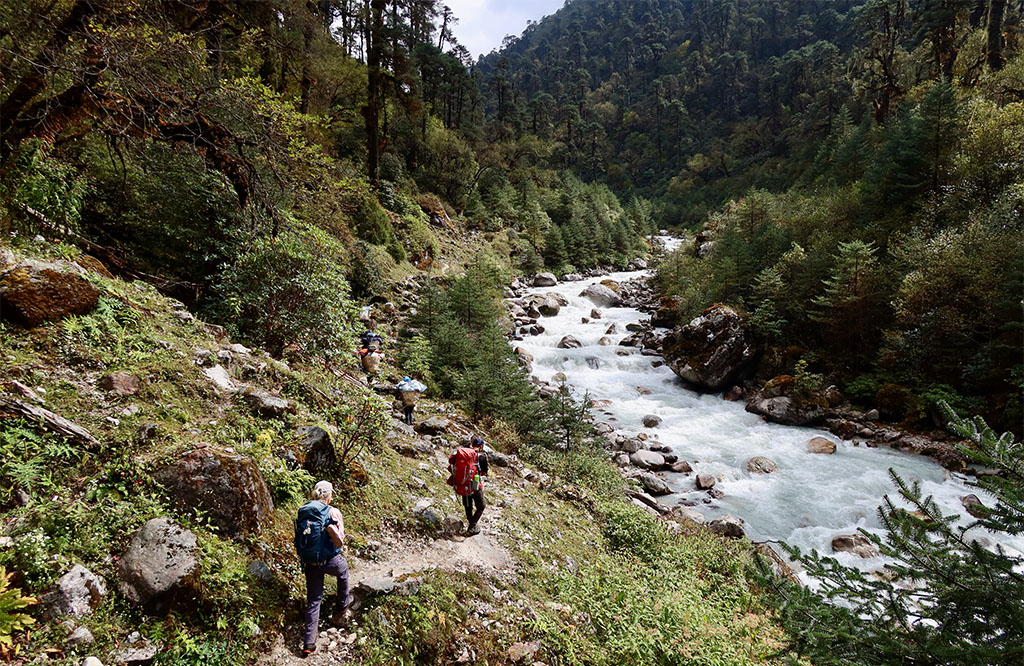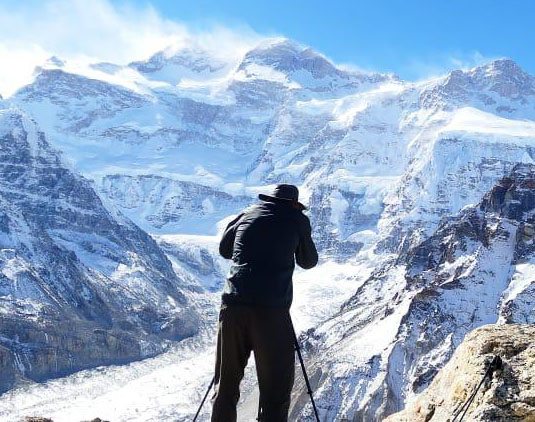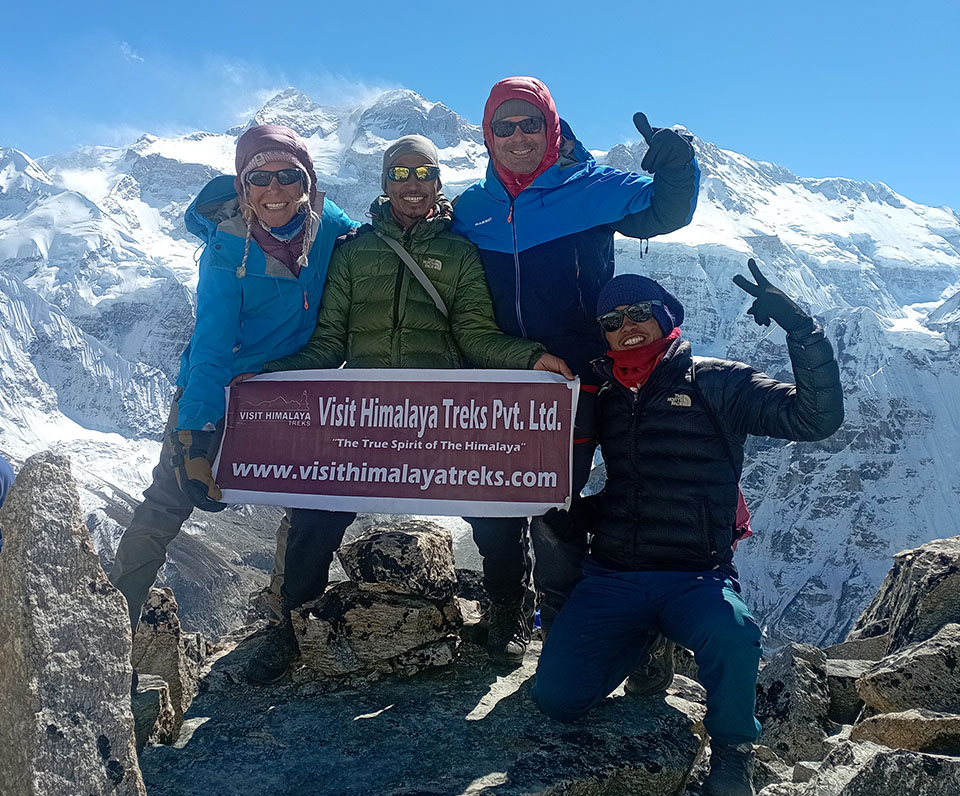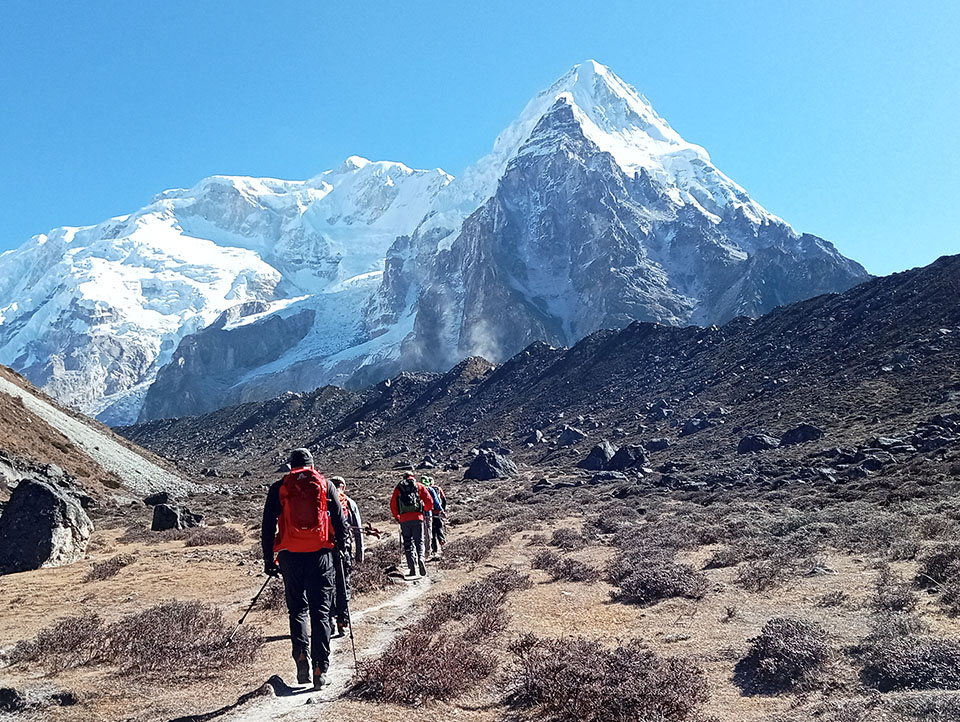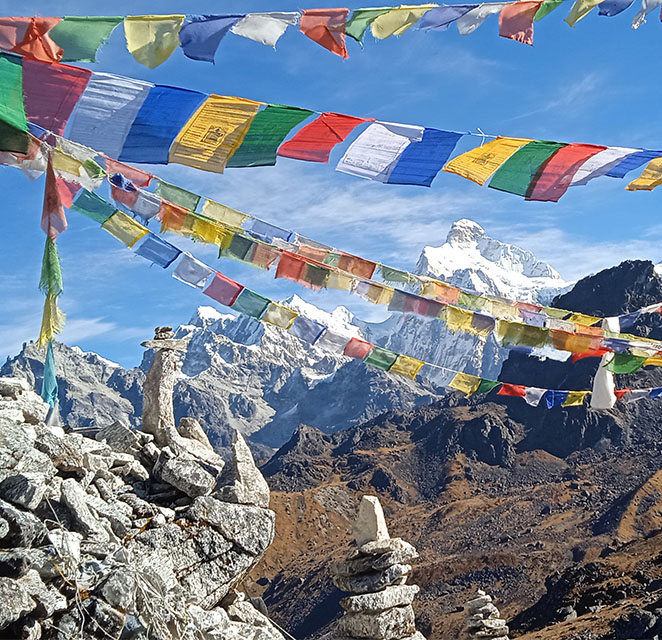Hidden in the isolated far eastern corner of Nepal, the Kanchenjunga Base Camp Trek is an untouched secret to mass tourism, a paradise for keen photographers and nature lovers. This incredible trek ventures deep into the Kanchenjunga Conservation Area, offering pristine alpine landscapes, secluded river valleys, high mountain passes, and the overwhelming presence of Mount Kanchenjunga, the world's third-highest peak. Unlike other more commercialized treks in Nepal, the trail here is uncontrolled and intimate, perfect for capturing Nepal's rugged beauty on film.
From the rich culture of Rai and Limbu settlements to dramatic ridgelines covered with rhododendrons and vistas of sparkling glaciers, every turn of this trail has something visually arresting. Whether you're photographing the very first rays of golden light on the snow face of Kanchenjunga, the spiritual peace of ancient monasteries, or the unguarded moments of daily life in isolated Himalayan settlements, this trek is a photographer's dream waiting to be documented.
Join Visit Himalaya Treks on a lifetime photography trek in one of Nepal's most beautiful and least-visited trekking routes. This trek is less about reaching base camp, but more about creating anecdotes, capturing stills, and filming the spirit of the mountains through your lens.
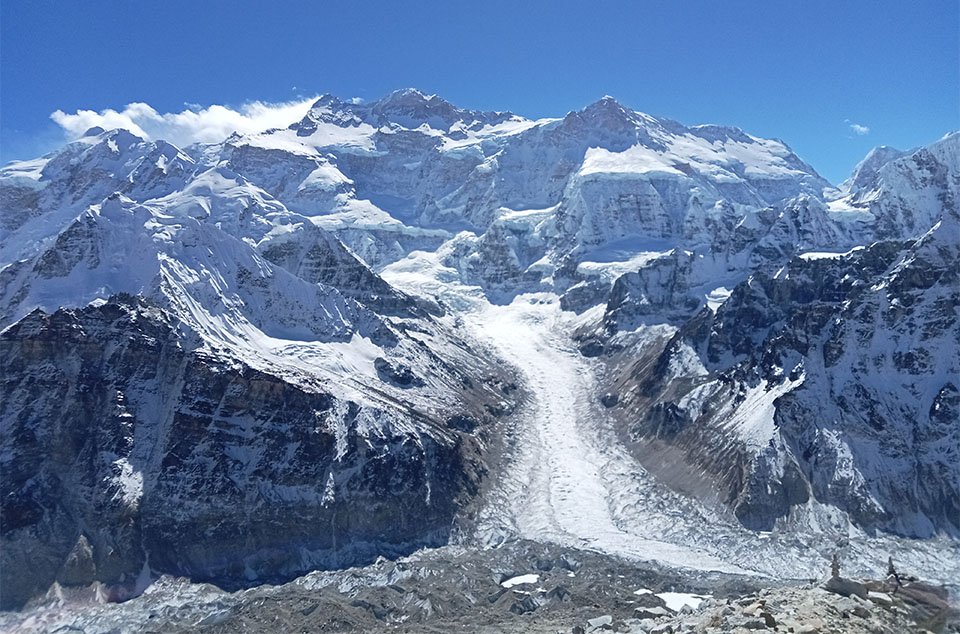
Kanchenjunga North view from the Dhromo Ri View Point.
Best Photographic Locations on the Kanchenjunga Base Camp Trek,
The Kanchenjunga Base Camp Trek is heaven for photographers with everything from high alpine landscapes to intimate cultural settings. Some of the most stunning and photographically rewarding places along the detailed route are:
1. Mitlung and Chiruwa
These early parts of the trek pass through the fertile lower valleys of eastern Nepal. Mitlung and Chiruwa are marked by dense forest, tumbling waterfalls, rice paddies on stepped terraces, and vibrant village life. There will be opportunities for taking pictures of rural daily life, farmers tilling the soil, playing with children, women weaving baskets, against a hill forest backdrop. Morning and late-afternoon sun is warm and deep, perfect for narrative shots typical of traditional Himalayan society.
2. Gyabla and Amjilosa
As you make your way further up the trail, moods and tones of forest scenery begin to shift. Frequently, when advancing towards Gyabla and Amjilosa are slim gorges saturated with a local morning mist that creates an atmosphere that is mysterious as well as serene. There are great degrees of contrast and depth here and, therefore, terrific opportunities for moody forest photography. Sunlight passing through the pine and rhododendron forests can produce dramatic vistas, especially if you wish to shoot with a game of light and shade.
3. Ghunsa Village
Ghunsa is arguably the most picturesque village on the whole Kanchenjunga Circuit Trek. Situated at 3,595 meters, it is in a wide glacial valley ringed by snow-capped peaks. The village itself, with its wooden buildings woodenly clad in traditional stone, turning prayer wheels, and fluttering rainbow-colored prayer flags, is a draw for both architectural and cultural photography. Herds of yaks moving through and locals carrying out their morning chores add life and dimension to your photographs. Sunrise and sunset here are especially magical as the village absorbs soft alpenglow.
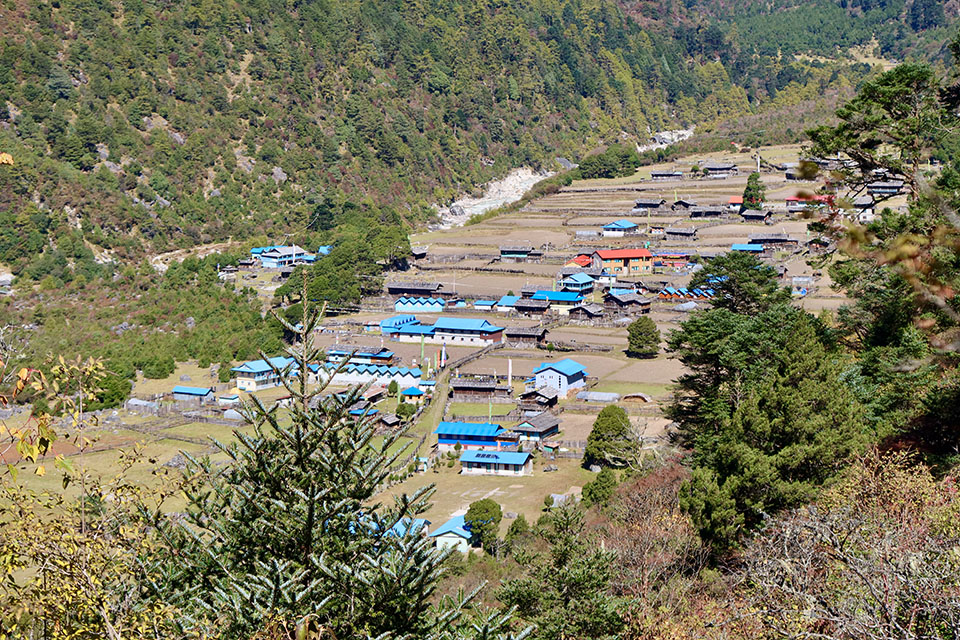
Ghunsa Village, a Lovely traditional Sherpa Village, is en route to the Kanchenjunga North Base Camp Trekking Route.
4. Lhonak
At a breathtaking 4,780 meters, Lhonak is a windswept, solitary high-altitude camp with enormous open grasslands. It's where the raw power of the Himalayas is revealed in stark relief. Here, the landscape is desolate but breathtakingly beautiful and thus apt for minimalist and wide-angle photography. From this height, you can take panoramic shots of mountain ridges looming above you, glacial moraines, and rugged rocky outcrops. The absolute emptiness and silence of this area appear breathtaking in images that attempt to show the scale and inaccessibility of the upper Himalayas.
5. Pangpema – North Kanchenjunga Base Camp
Pangpema at 5,143 meters is quite possibly the most camera-friendly spot on the trek. It has a direct, unimpeded view of the northern face of Mount Kanchenjunga, the world's third-highest peak. The optimal time to photograph here is at sunrise or sunset, when the golden glow bathes the towering peaks and the glacier below glows with shifting colors. It's a location to capture that iconic mountain photo, a dramatic landscape of snowy peaks, shifting clouds, and the earth's raw texture. Drones are also possible here (where permitted) for sweeping aerial photography.
6. Dhromo Ri View Point
From the Drohmo Ri viewpoint, you can get a close-up view of the Kanchenjunga North side views during your trek to Mount Kanchenjunga. Not many people are aware of the Drohmo Ri viewpoint. It is located at the top of Pang Pema (Kanchenjunga North Base Camp) at an elevation of about 5,900 meters. Climbing to the Drohmo Ri viewpoint does not require any prior climbing experience, as there are no technical climbing skills involved. It takes approximately 4 to 5 hours to reach the Drohmo Ri viewpoint from Pang Pema. Trip of the day, Hike to Drohmo Ri viewpoint provides a 360-degree view of Kanchenjunga North and the surrounding Himalayan peaks.
7. Ramche and Yalung Glacier (South Base Camp Side)
If your trek is the southern route, Ramche offers another chance for high-mountain drama photography. Yalung Glacier and the blue ice lakes close by capture the grandeur of the Kanchenjunga South Face. The terrain of this part of the trek consists of rugged glacier valleys, tiered ridges of mountains, and the sweeping landscape of alpine wilderness. Contrasts of light and rock can create dramatic photographs, and open ground allows for cinematic, wide-angle compositions.
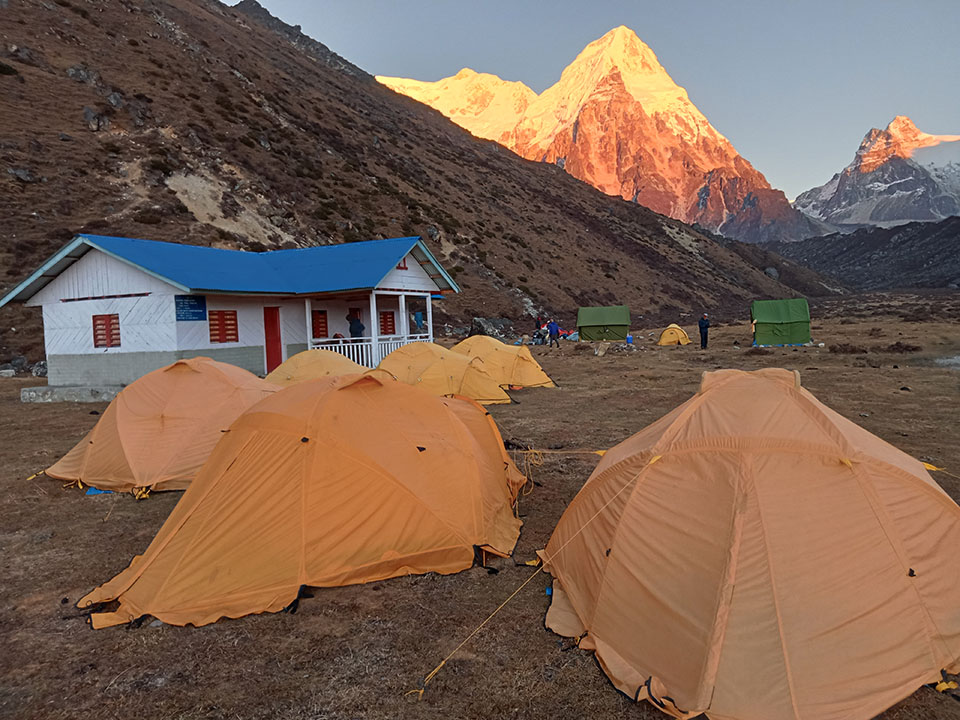
Our camp at Ramche, Kanchenjunga South Base Camp, organized by Visit Himalaya Treks.
8. Oktang View Point 4730 meters
The Key Objective of the KBC South Base Camp trek is to stand at Oktang viewpoint, which provides a breathtaking view of the world's third-highest Peak and its Glacier, which is a massive glacier that descends from the slopes of Kanchenjunga and Yalung Khang. A combination of mountains, glaciers, and Landscapes creates a fascinating panorama.
9. Cultural Monuments
Scattered around the Kanchenjunga region are small gompas (monasteries), mani walls, and prayer wheels that are sacred to Buddhists. These spiritual destinations are steeped in culture and photogenically enriching. Photographers have the chance to highlight carved mani stones' texture, vibrant colors of traditional murals, and monk and villager faces during moments of regard. Framing the waving of prayer flags on the wind, or the silence of a meditating monk, offers powerful images that tell richer stories of the spiritual life in the Himalayas.
Each of these locations offers its own unique light, atmosphere, and story, thereby making the Kanchenjunga Base Camp Trek a photographer's own paradise where one discovers nature's grandeur as well as cultural reality.
What Photography Gear to Bring for the Kanchenjunga Base Camp Trek?
Capturing the raw, untouched beauty of the Kanchenjunga region requires more than a good eye, but the right gear to face varying weather, extreme altitude, and tough terrain. Here's what all photographers need to bring in the Kanchenjunga Base Camp Trek:
1. Camera Body
A mirrorless or DSLR camera that is light is ideal for trekking. Mirrorless systems like the Sony Alpha series or Canon R series are extremely compact and give great image quality. Ensure your camera is weather-sealed or keep a rain cover.
2. Lenses
Wide-angle lens (16–35mm) to shoot sweeping Himalayan panoramas, monasteries, and star-filled skies.
- Standard zoom (24–70mm) for general day-to-day photography.
- Telephoto lens (70–200mm) for wildlife, distant mountains, and candid portraits from afar.
You don't have to carry all three if weight is a concern; choose two that will work best for your style of shooting.
3. Tripod
A light and compact tripod is a must for long exposures, night-time shots, and time-lapses. Carbon fiber tripods are strong and lighter, but pricey. Choose models that are collapsible and will fit in your daypack easily.
4. Filters
Polarizing filter to allow for opening up skies and reducing glare on rivers and snow.
ND filters to allow long exposure even during the day (ideal for waterfalls and flowing clouds).
UV filter to protect your lens in high-altitude UV-intensive conditions.
5. Spare Batteries and Memory Cards
Batteries drain quickly in cold conditions, so carry 3–4 fully charged spares with you. High-write-speed memory cards (64GB and above) are essential for RAW photography.
6. Waterproof Protection and Dry Bags
Keep dry bags or zip locks for cards, batteries, and cameras as an emergency backup in the event of an unexpected rain or snow. A plastic sleeve or a rain cover for your camera can save your gear in inclement weather.
7. Solar Charger or Power Bank
Tea house charging stations might be limited or cost extra. A reliable power bank (20,000mAh+) and/or a solar panel foldable charger will keep your gear powered up during the hike.
8. Lens Cleaning Kit
Dust, snow, and moisture will quickly fog or dirty up your lens. A basic cleaning kit of a microfiber cloth, blower, and lens cleaning solution is essential.

Janu Himal, also known as Kumbhakarna, is one of the most beautiful mountains in the Kanchenjunga North Base Camp, Nepal.
FAQs: Kanchenjunga Base Camp Trek Photography,
1. Do I need a professional camera to obtain the trek?
Not at all. Although DSLRs or mirrorless cameras offer more control and better pictures, the majority of trekkers employ high-end phones or point-and-shoot cameras and still manage to produce amazing photographs. However, for serious photographers who desire large prints or publication, a manual camera with interchangeable lenses is necessary.
2. Is it safe to carry expensive photography gear on the trek?
Yes, it is very safe, especially if you are trekking with a good company such as Visit Himalaya Treks. But always, carry your gear in your daypack (not included in the porter load), use padded, water-resistant bags, and look after your gear in teahouses and public areas.
3. Will I have access to electricity to charge camera batteries?
Electricity is available at most teahouses en route, especially in lower villages like Ghunsa or Yamphuding. It's, however, unreliable and occasionally charged separately. Bring spares of batteries, and it is good to carry a solar charger or power bank as a backup.
4. Is the use of drones allowed on the Kanchenjunga Trek?
Drone operation in Nepal is regulated. In order to operate a drone legally, you will be required to obtain permission from the Civil Aviation Authority of Nepal and the Ministry of Home Affairs, and permission from the Kanchenjunga Conservation Area Office. Operating a drone illegally is strictly prohibited and can result in penalties or seizure.
5. Do there need to be any cultural considerations made when photographing locals?
Yes. Always ask permission first when taking a photo of someone's face, especially in the less touristy areas of the country, where they may be camera-phobic. Avoid taking pictures of religious ceremonies and do not shoot shots of monastery interiors without asking.
6. What is the best time of day to take pictures on the trail?
Early morning and late afternoon offer the best natural light. The "golden hour" light adds depth to the warm colors and rich textures of the Himalayan landscapes. Portrait and village scenes are best photographed in mid-morning when people are busy, but light remains soft.
7. Can I take photographs of wildlife during the trek?
Yes, but wildlife is unpredictable. Use a telephoto lens if you're expecting to capture photos of animals like blue sheep or red pandas. Move slowly and quietly, and always leave them alone. Never bait or disturb wildlife in hopes of getting a photo.

